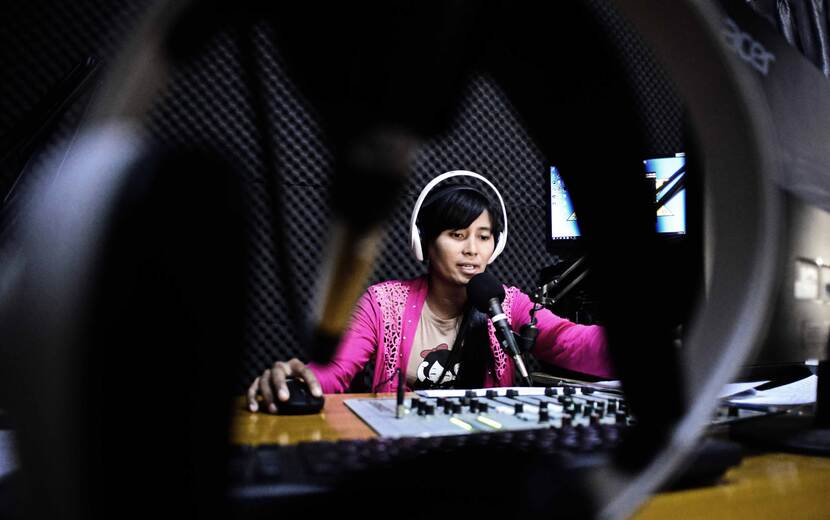Creating a safe environment for women journalists
Weblogs
Seventy-three per cent of women journalists have experienced online violence, causing them to choose their words more cautiously or even avoid certain subjects altogether. One third of female journalists are even considering leaving the profession. Flora Schulte Nordholt of Free Press Unlimited says: ‘That won’t be good for media freedom or for journalism itself.’
Although male journalists face violence too, the attacks that women experience are of a different nature: hateful messages, rape threats or having their faces photoshopped onto pornographic images. The violence that women journalists encounter is more likely to be sexist and is rooted in misogyny. At one point last year, journalist Rana Ayyub from India was receiving 26,000 hate tweets per day. ‘I’m not just a woman, I’m a Muslim too. In India I’m regarded as a second-class citizen. How dare I express myself in the Washington Post?’ Rana can no longer go out in public without fear; she finds herself always looking over her shoulder.
At one point last year, journalist Rana Ayyub from India was receiving 26,000 hate tweets per day.
Aggression is on the rise
Seventy-three per cent of women journalists have experienced online violence in the course of their work, according to a survey by UNESCO and the International Center for Journalists (ICFJ), which collected data from 1,200 women throughout the world. In the Netherlands, the Dutch Association of Journalists (NVJ) has conducted a survey on the safety of women journalists. In this country too, 82% of women journalists have experienced aggression, intimidation and threats in the course of their work. Half of respondents say that behaviour of this nature has increased (or increased sharply) over the past five years.
Self-censorship
Online violence has a variety of consequences. Besides the mental harm it causes – like stress and insomnia – it also makes journalists more cautious in their choice of subjects and words. In the NVJ survey, 77% of respondents said that online violence often has a negative impact on their work. For instance, they may avoid social media or stop publishing on certain subjects. Some journalists have been unable to pursue their work due to aggression, threats and intimidation. According to a worldwide study, one in three women journalists have considered leaving the field as a consequence of online intimidation.
Physical violence
There is a thin line between online and physical violence. In the ICJF survey, 20% of the respondents said they have been abused and attacked offline after first being harassed online. ‘So we need to treat online violence with the same priority as offline violence,’ says Ruth Kronenburg, Executive Director of Free Press Unlimited. The Ministry of Foreign Affairs works with this partner organisation to promote press freedom all over the world. At the end of February 2023 Ms Kronenburg and her colleague Flora Schulte Nordholt (a policy officer at Free Press Unlimited) attended the UNESCO conference ‘Internet for Trust’, the first global conference on regulating digital platforms.
At present there is no clear definition of gender-based online violence in the community guidelines of social media platforms or in legislation. ‘That’s why there’s been no effective response yet,’ says Ms Schulte Nordholt. ‘Policymakers have a role to play in this respect. They can produce legislation that clarifies the definition of online violence and puts pressure on the platforms to prevent violence, protect women journalists and prosecute those responsible.’Online violence is on the rise. Ms Schulte Nordholt: ‘We really need legislation in order to hold platforms accountable, because in practice we’ve seen that self-regulation doesn’t work.’ Ms Kronenburg concludes that social media platforms generally fail to take responsibility. ‘They make all kinds of excuses: that they don’t have the staff or that it’s difficult to find somebody who speaks the right language. It’s simply not a priority for them.’
'If women are also forced to leave journalism due to online intimidation, then we’ll end up with the news being brought to us predominantly by men.'
Create a safe online environment
Free Press Unlimited is calling on all stakeholders to take action: editorial teams, digital platforms and policymakers. According to Ms Schulte Nordholt, three things need to be done to create a safe environment for women in the media. First, editorial teams must protect and support their female staff. Second, social media platforms need to take more responsibility in this area. And third, policymakers must put in place better legislation to tackle online violence. ‘Finally, there also need to be 'escalation channels', where you can report violence so that the content in question can be taken offline quickly. This work shouldn’t be done by automated systems, but by real people who speak the local language and are familiar with the cultural context.’
Threat to freedom of expression
The UNESCO conference discussed proposals for a model regulatory framework. However, these guidelines for online platforms do not address the fundamental threats posed to the freedom of expression and the safety of journalists (in particular women). Ms Kronenburg stressed that the guidelines should explicitly define different types of harmful behaviour, including gender-based online violence.
‘We need to turn the tide because women are already underrepresented in newsrooms in many countries. If women are also forced to leave journalism due to online intimidation, then we’ll end up with the news being brought to us predominantly by men. That will have an impact on the choice of subjects and the perspectives from which the news is reported,’ says Ms Kronenburg. ‘Particularly in countries where women’s rights are under threat, it’s important for women to keep reporting the news.’
